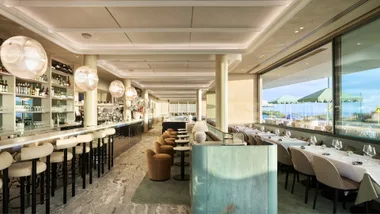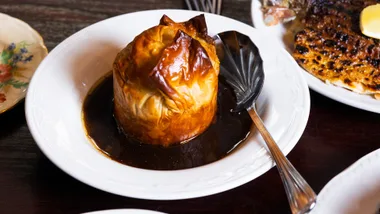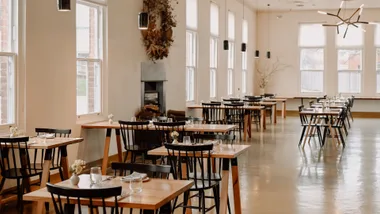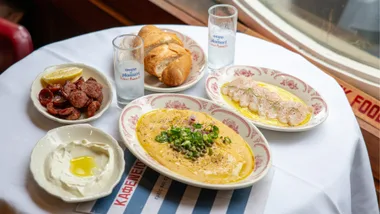At the end of the world – behind the mountains of discarded cat-eye sunglasses, Gen-Z yellow dresses, chunky dad sneakers, bike shorts once worn with blazers, bum bags and Birkenstocks, past the unclothed tables, chilled reds, skin-contact whites, queues out the front, kingfish crudo and jars of house-made XO sauce – we’ll still have Est serving $45 entrées and offering complimentary dessert with a $95 glass of Château d’Yquem. The world could be burning outside and the waitstaff wouldn’t miss a beat, calmly pouring flutes of Blanc de Blancs from the Champagne trolley and checking the creases in the linen to the very last.
Food and fashion can be a funny thing. Knowing whether to stick or twist isn’t easy when being new so often takes precedence over being good. When Peter Doyle, Est’s chef for 15 years, retired from its kitchen last year, he wrote in our pages that the best dishes were those that transcended trends, proving that good, clean-tasting food never goes out of style.
At Est your entrée might be fillets of baby snapper cooked, in a very early 2000s way, sous-vide in a steam oven. They’re served on a (very 2000s) bed of buckwheat and pearl-meat “risotto”. The sauce is butter-based.
These choices are not fashionable. But the snapper is sweet and fresh. It flakes delicately under pressure from a fork. Cooking fish in a bag may have been superseded by more manual methods – pan-frying, grilling, roasting – but when something works, it works. The butter sauce, a light and foamy emulsion, coats the palate, with an edge from yuzu kosho the slightest concession to the times. Crisped puffed buckwheat piled on top of the fish adds crunch. It’s technical and pulled off with common sense. What’s more, it’s good and clean-tasting.

Est head chef Jacob Davey
Jacob Davey, Doyle’s head chef before Peter Doyle left and the man Merivale installed as his successor, couldn’t have asked for a better dictum. And despite the challenge of succeeding someone who’s been at the top of their game for so long, he’s done well to keep to the path.
But surely it’s a path that’s narrowing. In this city, Est is one of the last of its kind, a restaurant that brings together the established codes of fine dining and sticks with them because it believes that is the way it should be done. Double-clothed tables, the finest glassware, the most classic of wine lists, salt on the table, a fierce dedication to service. The room itself almost demands it. Pressed-metal ceilings soar, soft light spills through the front windows, plush banquettes are strewn with cushions. It’s comfort and elegance all at once. Even the toilet paper is branded Indulgence.
Whether Est presents in 2019 as hushed or stifled, classic or stale, polished or stiff, is probably in the eye of the beholder. Near to our table, a solicitor sits at a two-top with an off-menu order of French fries.

Crab with cavolo nero, hazelnut, horseradish, trout roe and lemon jam.
Want to talk classic? How about a meaty tumble of spanner crab topped with trout roe and a chiffonade of cavolo nero and underscored by lemon jam. Want to talk polished? Try abalone, roasted and sliced thin, served on a collagen-rich braise of pig’s trotter cut through with capers and finished with parsley oil. A finger of toast spread with abalone-liver butter and topped with dill, parsley and chervil checks the savouriness. Both dishes show the produce in its best light.
Blame the format rather than the execution if the main courses feel dated by comparison. The general trend in higher-end restaurants towards large-format dishes following a flurry of snacks and entrées is recognition, if nothing else, that the most interesting things are often found at the front of menus. The mains at Est are fine. Better than fine. A dish of Spanish mackerel sees the fish cooked to the right point, skin smoky and blackened, flesh opalescent, bitter wilted radicchio and sweet beetroot playing off each other. And the jus on a dish of lamb loin with anchovy-bread sauce and kutjera is clear and refined, even if the striated rectangle of squash and zucchini it comes with gets by on its looks more than anything.
But then halfway through our course, waiters swarm a nearby table, dropping split rock lobsters and bone-in sirloins with a sense of ceremony. There’s excitement after all – even if it is a little clichéd – it just comes at a price.

Roasted abalone with pig’s trotter, capers, parsley and herb toast.
The sides, meanwhile, are a chance for the kitchen to show off its considerable prowess with the simple things. Lettuce leaves and fines herbes. Fried cauliflower under a parmesan-cream sauce showered with wakame. Big deep-fried batons of grated potato flavoured with wagyu fat, reminiscent of McDonald’s hash browns – just a bit better, if that were possible.
Est certainly has polish. The waiters are at once warm and professional, knowing how to turn it on for a special occasion or take a back seat if you’re closing a deal. My response to anyone who wants more excitement on the wine list would be that someone has to do classic, and at Est they make a point of going hard at it. Sommelier Dheeraj Bhatia oversees a list that’s a lesson in wine regions and houses: Mosel riesling, Etienne Sauzet chardonnay, Saint-Émilion Grand Cru, plus prestigious Australian labels, including a back catalogue of Grange. It’s the best fun you’ll have with an encyclopedia.

The wine selection at Est.
Dessert is a class act, too. Valrhona chocolate mousse, cut into thick pieces, is dense and rich and dark and plated with paper-thin leaves made with prune and potato, muscat ice-cream made with liquid nitrogen, and a sweet buttery pumpkin sauce. It’s a mouthful, but it’s solid and rousing. A vacherin resembling a hard-packed snowball is all poise and balance, a raspberry coulis (now there’s a throwback) underpinning a filling of raspberry sorbet and buffalo-milk curd.
It feels important that as the world spins around it, Est remains staunchly wedded to the ideals of taking good produce, cooking it well and presenting it with flair, trying to be nothing other than the best at what it does. Est is Latin, you know. It means “it is”. It simply is.
-scaled.jpg?fit=900%2C750)










